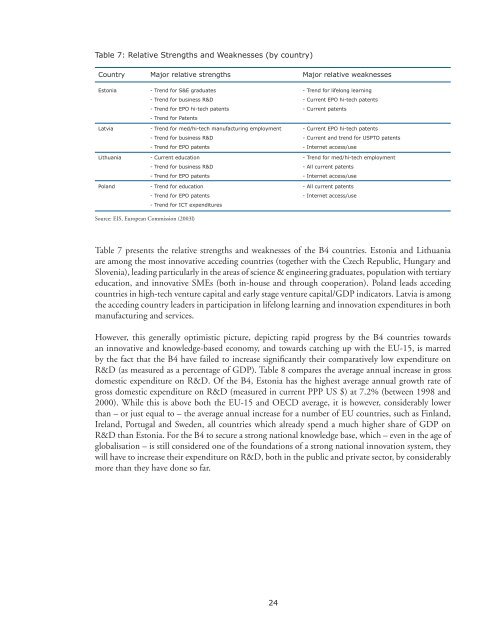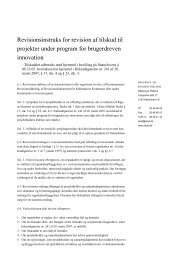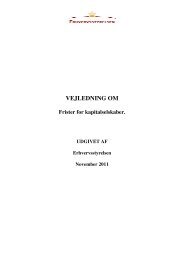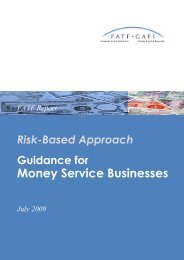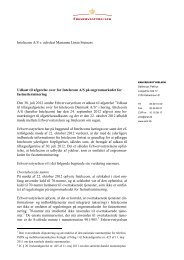Competing in the Single Market - SMEs and ... - Erhvervsstyrelsen
Competing in the Single Market - SMEs and ... - Erhvervsstyrelsen
Competing in the Single Market - SMEs and ... - Erhvervsstyrelsen
You also want an ePaper? Increase the reach of your titles
YUMPU automatically turns print PDFs into web optimized ePapers that Google loves.
Table 7: Relative Strengths <strong>and</strong> Weaknesses (by country)Country Major relative strengths Major relative weaknessesEstoniaLatviaLithuaniaPol<strong>and</strong>- Trend for S&E graduates- Trend for bus<strong>in</strong>ess R&D- Trend for EPO hi-tech patents- Trend for Patents- Trend for med/hi-tech manufactur<strong>in</strong>g employment- Trend for bus<strong>in</strong>ess R&D- Trend for EPO patents- Current education- Trend for bus<strong>in</strong>ess R&D- Trend for EPO patents- Trend for education- Trend for EPO patents- Trend for ICT expenditures- Trend for lifelong learn<strong>in</strong>g- Current EPO hi-tech patents- Current patents- Current EPO hi-tech patents- Current <strong>and</strong> trend for USPTO patents- Internet access/use- Trend for med/hi-tech employment- All current patents- Internet access/use- All current patents- Internet access/useSource: EIS, European Commission (2003l)Table 7 presents <strong>the</strong> relative strengths <strong>and</strong> weaknesses of <strong>the</strong> B4 countries. Estonia <strong>and</strong> Lithuaniaare among <strong>the</strong> most <strong>in</strong>novative acced<strong>in</strong>g countries (toge<strong>the</strong>r with <strong>the</strong> Czech Republic, Hungary <strong>and</strong>Slovenia), lead<strong>in</strong>g particularly <strong>in</strong> <strong>the</strong> areas of science & eng<strong>in</strong>eer<strong>in</strong>g graduates, population with tertiaryeducation, <strong>and</strong> <strong>in</strong>novative <strong>SMEs</strong> (both <strong>in</strong>-house <strong>and</strong> through cooperation). Pol<strong>and</strong> leads acced<strong>in</strong>gcountries <strong>in</strong> high-tech venture capital <strong>and</strong> early stage venture capital/GDP <strong>in</strong>dicators. Latvia is among<strong>the</strong> acced<strong>in</strong>g country leaders <strong>in</strong> participation <strong>in</strong> lifelong learn<strong>in</strong>g <strong>and</strong> <strong>in</strong>novation expenditures <strong>in</strong> bothmanufactur<strong>in</strong>g <strong>and</strong> services.However, this generally optimistic picture, depict<strong>in</strong>g rapid progress by <strong>the</strong> B4 countries towardsan <strong>in</strong>novative <strong>and</strong> knowledge-based economy, <strong>and</strong> towards catch<strong>in</strong>g up with <strong>the</strong> EU-15, is marredby <strong>the</strong> fact that <strong>the</strong> B4 have failed to <strong>in</strong>crease significantly <strong>the</strong>ir comparatively low expenditure onR&D (as measured as a percentage of GDP). Table 8 compares <strong>the</strong> average annual <strong>in</strong>crease <strong>in</strong> grossdomestic expenditure on R&D. Of <strong>the</strong> B4, Estonia has <strong>the</strong> highest average annual growth rate ofgross domestic expenditure on R&D (measured <strong>in</strong> current PPP US $) at 7.2% (between 1998 <strong>and</strong>2000). While this is above both <strong>the</strong> EU-15 <strong>and</strong> OECD average, it is however, considerably lowerthan – or just equal to – <strong>the</strong> average annual <strong>in</strong>crease for a number of EU countries, such as F<strong>in</strong>l<strong>and</strong>,Irel<strong>and</strong>, Portugal <strong>and</strong> Sweden, all countries which already spend a much higher share of GDP onR&D than Estonia. For <strong>the</strong> B4 to secure a strong national knowledge base, which – even <strong>in</strong> <strong>the</strong> age ofglobalisation – is still considered one of <strong>the</strong> foundations of a strong national <strong>in</strong>novation system, <strong>the</strong>ywill have to <strong>in</strong>crease <strong>the</strong>ir expenditure on R&D, both <strong>in</strong> <strong>the</strong> public <strong>and</strong> private sector, by considerablymore than <strong>the</strong>y have done so far.24


